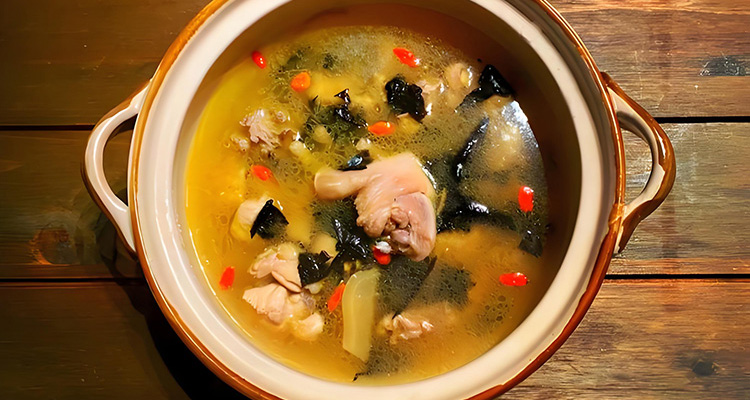Stone Ear Chicken: Huangshan’s Nourishing Winter Soup
1. Origin and History: Wisdom from the Cliffs
The story of Stone Ear Chicken is deeply rooted in Huangshan’s natural environment. Since the Ming and Qing dynasties, locals have treasured the stone ear—a lichen-like mountain delicacy that grows on sheer cliffs—and paired it with free-range chickens raised in the valleys. Slow simmering produced a richly nourishing soup, once reserved for merchants and scholars. Today, it remains a beloved household dish, especially in the cooler months.
2. Cultural Significance: The Heart of Hui Cuisine
As one of the most representative dishes in Hui cuisine, Stone Ear Chicken reflects the region’s “food as medicine” philosophy. In Huangshan, seasonal eating and nutritious soups are central to daily life. Enjoying this dish offers not only a comforting taste but also insight into Hui culinary traditions and local wellness culture.

3. Key Ingredients: Treasures from Nature
The soup relies on two prized local ingredients. Free-range chicken from Huangshan’s mountain villages features thin skin, firm meat, and a concentrated chicken aroma. The stone ear fungus, found above 800 meters on shaded cliff faces, has a gray-black top and brown underside—rich in collagen, amino acids, and minerals. It’s a true mountain treasure with remarkable texture and nutrition.
4. Cooking Method: Time Creates the Flavor
Authentic Stone Ear Chicken is all about patience. Dried stone ear is first soaked and cleaned. The chicken is blanched, then stewed together with the softened stone ear, ginger, and water in a clay pot. It’s simmered slowly for 2–3 hours until the chicken turns tender and the broth turns clear and aromatic. A touch of salt at the end preserves its natural, clean taste.
5. Flavor and Texture: Comfort in Every Spoonful
The finished soup is crystal-clear with a delicate golden sheen. The chicken is tender and richly savory, while the stone ear is silky and slightly springy, carrying a subtle mountain fragrance. The broth perfectly balances the depth of chicken essence with the light, earthy notes of the stone ear—warm, mellow, and satisfying.
6. How to Enjoy: Traditional Serving Tips
Traditionally, diners sip the soup first before enjoying the chicken and stone ear. The warmth spreads through the body, making it perfect for cold-weather dining. Locals often dip the chicken in a simple sauce of soy sauce, minced garlic, sesame oil, and chili oil for extra flavor. Paired with a bowl of steamed rice, it’s a wholesome and comforting meal.

7. When and Where to Eat: Best Season and Spots
Stone Ear Chicken is best enjoyed in autumn and winter, especially after hiking in the Huangshan Mountains. Look for restaurants advertising “local free-range chicken” and “Huangshan stone ear” for authentic flavors. Be patient—true Stone Ear Chicken takes time to cook slowly and should be served freshly simmered.
8. Visitor Tips: Finding the Most Authentic Taste
For the most authentic version, head to Tongkou Town at the foot of Huangshan or traditional eateries around Yi County. These restaurants often use their own farm-raised chickens and locally sourced stone ear fungus. Expect to pay around RMB 80–150 per dish (shared). You can also request a lighter broth with less oil. On rainy or misty days, a steaming bowl feels especially heartwarming.
9. Simple Home Recipe: Bring Huangshan Home
You can recreate a simplified version at home. Use a fresh village chicken or Sanhuang chicken, and purchase dried stone ear from herbal shops or supermarkets. Blanch the chicken, add the soaked stone ear and enough water, then simmer for about 1.5 hours. Season with salt to taste. While it may not match a slow-simmered restaurant version, it still captures the comforting essence of this Huangshan specialty.
Summary: More Than a Dish
Stone Ear Chicken (Shi’er Stewed Chicken) is more than a meal—it’s a taste of Huangshan’s heritage. Blending mountain delicacies and free-range poultry, it embodies Hui cuisine’s philosophy of nourishment and balance. Whether you seek culture, comfort, or seasonal wellness, a bowl of this soup offers a warm and memorable experience of Huangshan cuisine.


